sensor TOYOTA SIENNA 2018 (in English) Service Manual
[x] Cancel search | Manufacturer: TOYOTA, Model Year: 2018, Model line: SIENNA, Model: TOYOTA SIENNA 2018Pages: 584, PDF Size: 14.47 MB
Page 301 of 584
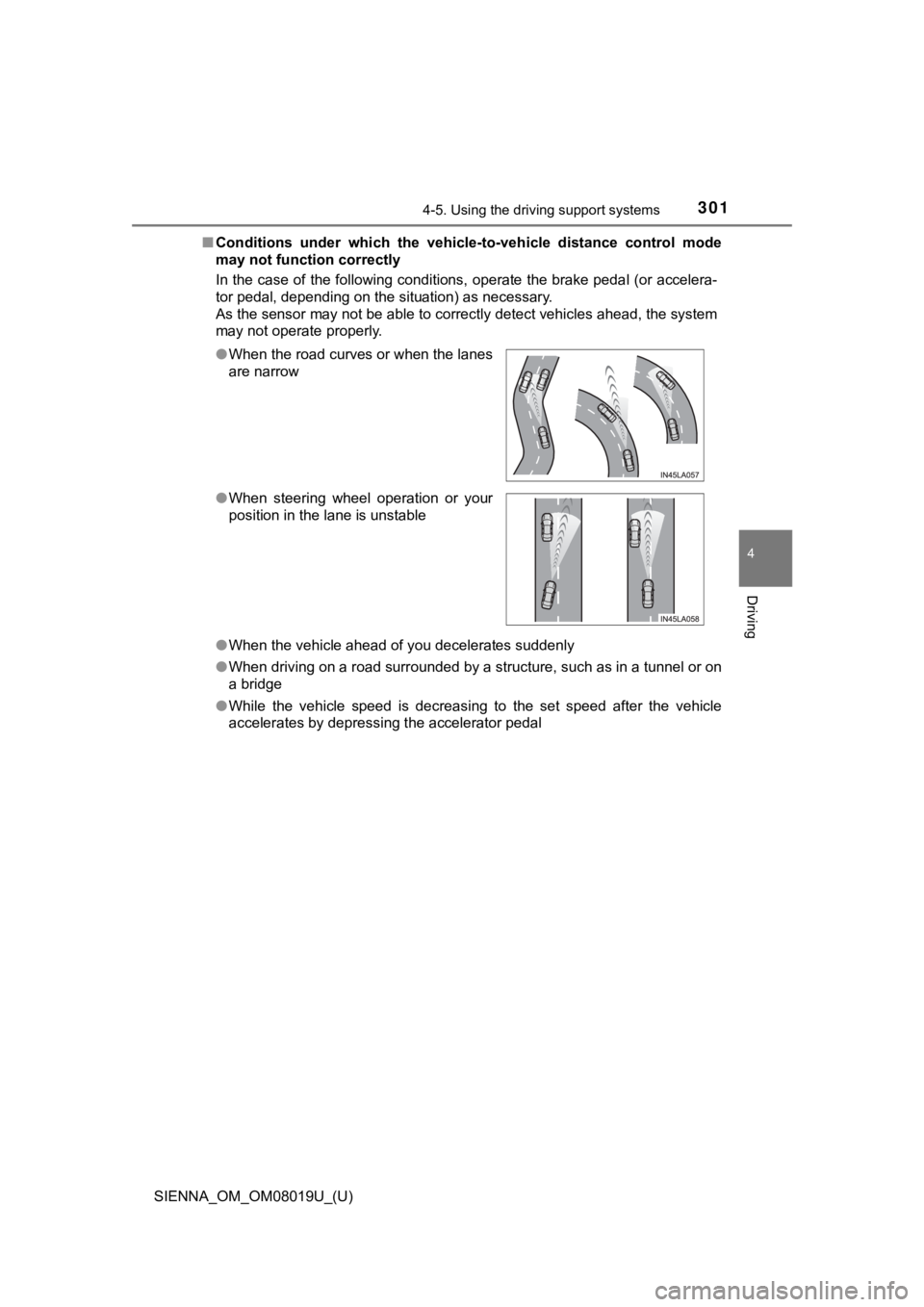
SIENNA_OM_OM08019U_(U)
3014-5. Using the driving support systems
4
Driving
■Conditions under which the vehic le-to-vehicle distance control mode
may not function correctly
In the case of the following conditions, operate the brake peda l (or accelera-
tor pedal, depending on the situation) as necessary.
As the sensor may not be able to correctly detect vehicles ahead, the system
may not operate properly.
● When the vehicle ahead of you decelerates suddenly
● When driving on a road surrounded by a structure, such as in a tunnel or on
a bridge
● While the vehicle speed is decreasing to the set speed after th e vehicle
accelerates by depressing the accelerator pedal
●
When the road curves or when the lanes
are narrow
● When steering wheel operation or your
position in the lane is unstable
Page 302 of 584
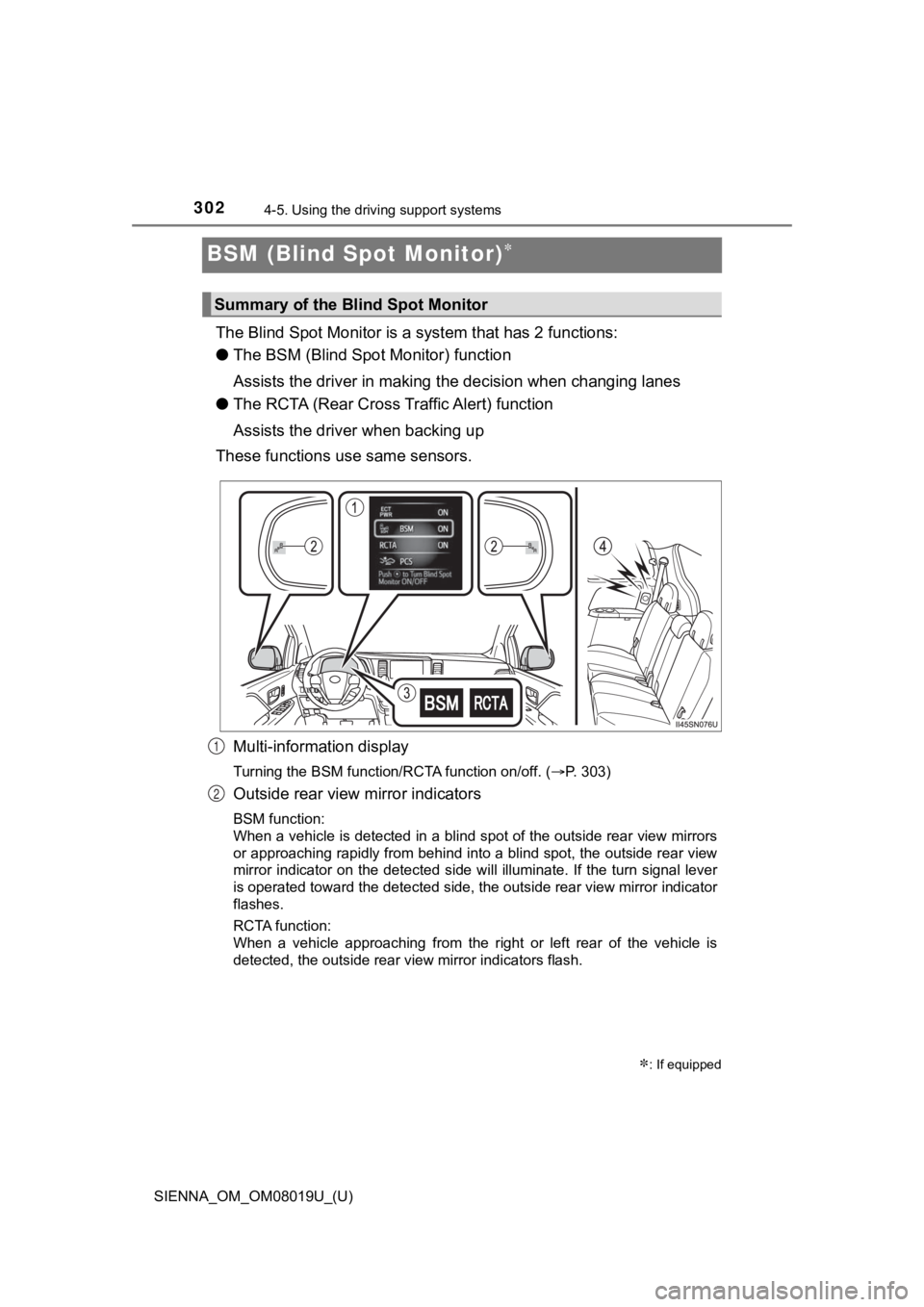
302
SIENNA_OM_OM08019U_(U)
4-5. Using the driving support systems
BSM (Blind Spot Monitor)
The Blind Spot Monitor is a system that has 2 functions:
● The BSM (Blind Spot Monitor) function
Assists the driver in making t he decision when changing lanes
● The RCTA (Rear Cross Tra ffic Alert) function
Assists the driver when backing up
These functions use same sensors.
Multi-information display
Turning the BSM function/RCTA function on/off. ( P. 303)
Outside rear view mirror indicators
BSM function:
When a vehicle is detected in a blind spot of the outside rear view mirrors
or approaching rapidly from behind into a blind spot, the outsi de rear view
mirror indicator on the detected side will illuminate. If the t urn signal lever
is operated toward the detected side, the outside rear view mir ror indicator
flashes.
RCTA function:
When a vehicle approaching from the right or left rear of the vehicle is
detected, the outside rear view mirror indicators flash.
: If equipped
Summary of the Blind Spot Monitor
1
2
Page 303 of 584
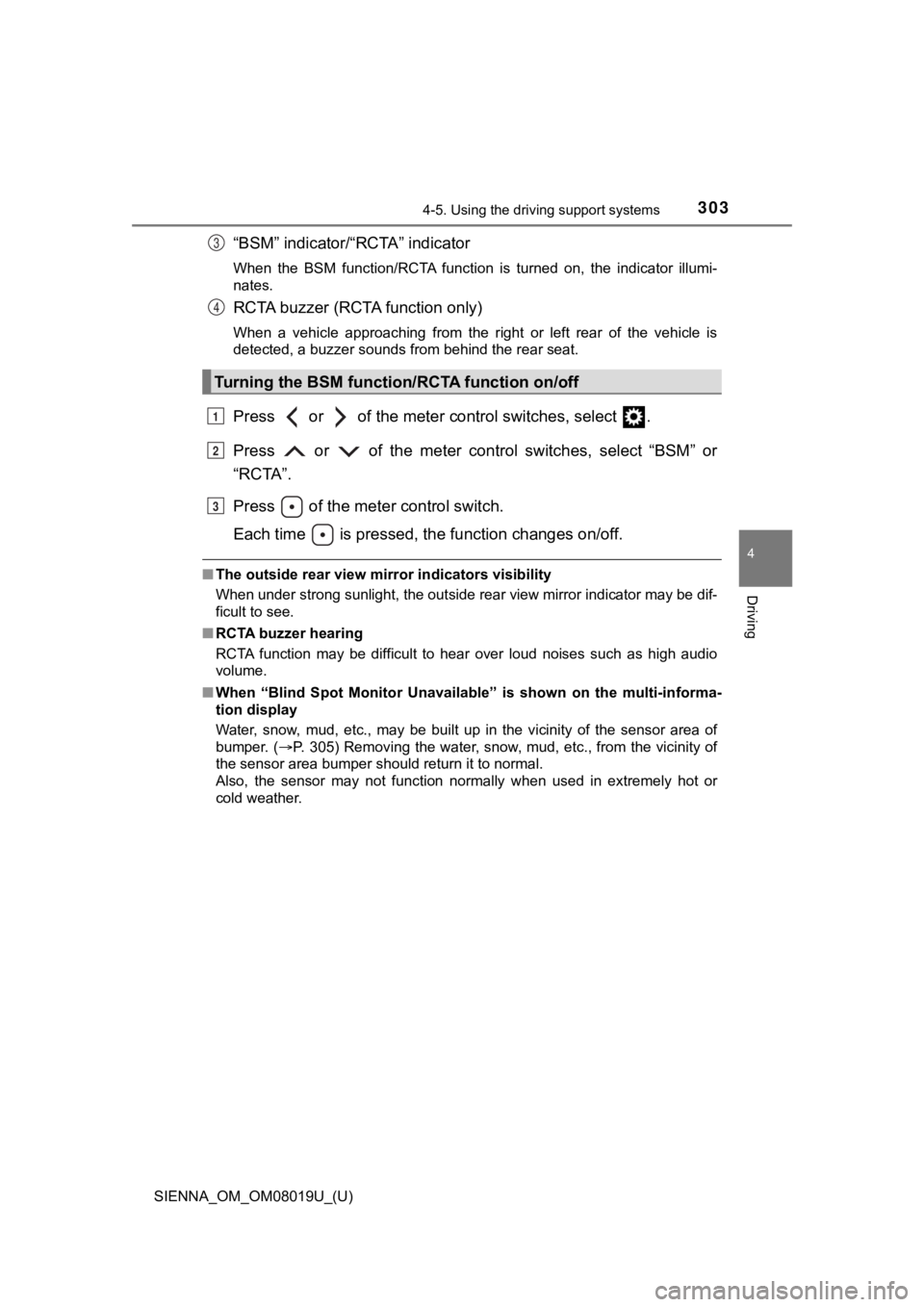
SIENNA_OM_OM08019U_(U)
3034-5. Using the driving support systems
4
Driving
“BSM” indicator/“RCTA” indicator
When the BSM function/RCTA function is turned on, the indicator illumi-
nates.
RCTA buzzer (RCTA function only)
When a vehicle approaching from the right or left rear of the vehicle is
detected, a buzzer sounds from behind the rear seat.
Press or of the meter c ontrol switches, select .
Press or of the meter control switches, select “BSM” or
“RCTA”.
Press of the meter control switch.
Each time is pressed, the function changes on/off.
■ The outside rear view mirror indicators visibility
When under strong sunlight, the outside rear view mirror indica tor may be dif-
ficult to see.
■ RCTA buzzer hearing
RCTA function may be difficult to hear over loud noises such as high audio
volume.
■ When “Blind Spot Monitor Unavailable” is shown on the multi-inf orma-
tion display
Water, snow, mud, etc., may be built up in the vicinity of the sensor area of
bumper. ( P. 305) Removing the water, snow, mud, etc., from the vicinity of
the sensor area bumper should return it to normal.
Also, the sensor may not function normally when used in extreme ly hot or
cold weather.
Turning the BSM function/RCTA function on/off
3
4
1
2
3
Page 305 of 584
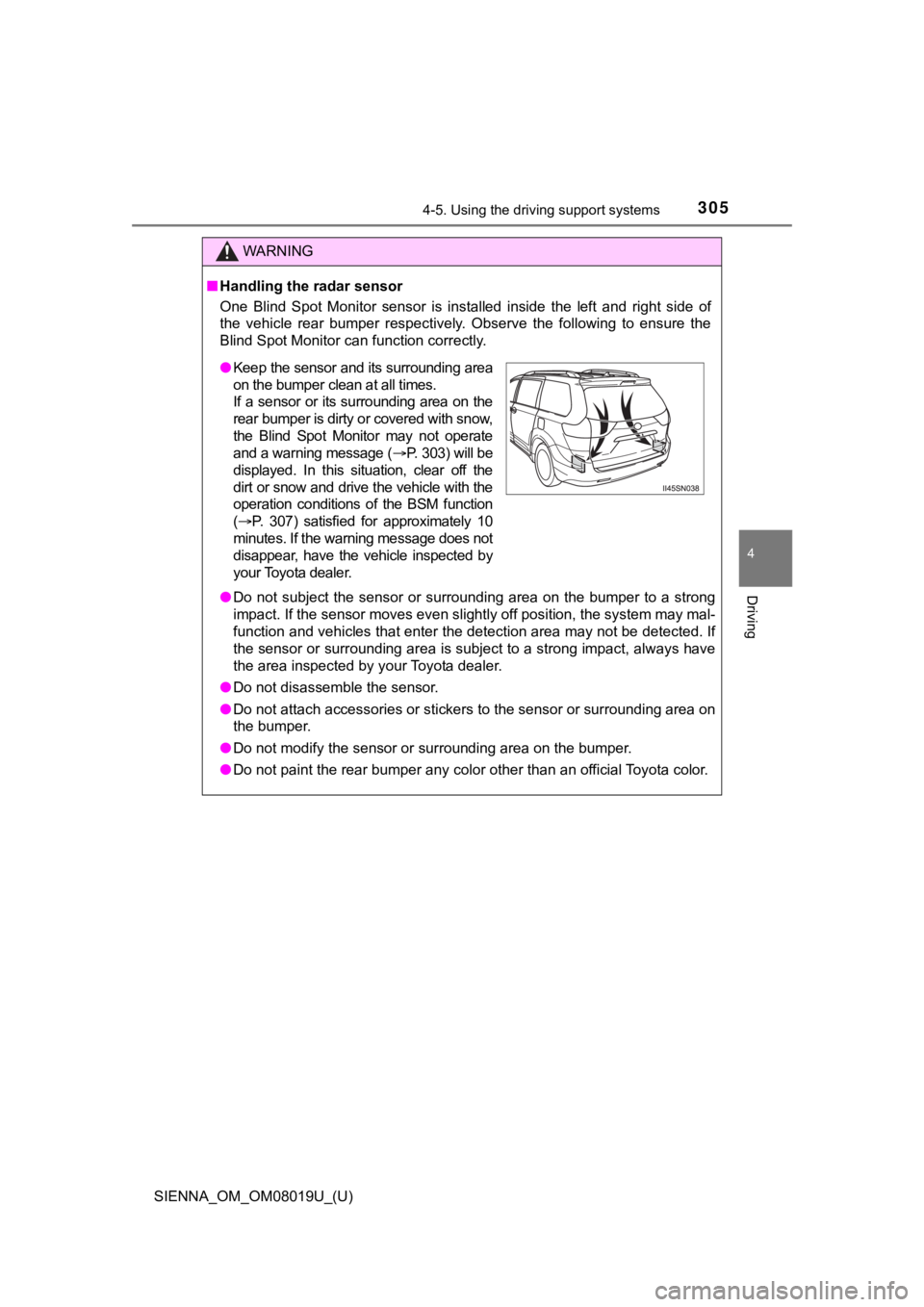
SIENNA_OM_OM08019U_(U)
3054-5. Using the driving support systems
4
Driving
WARNING
■Handling the radar sensor
One Blind Spot Monitor sensor is installed inside the left and right side of
the vehicle rear bumper respectively. Observe the following to ensure the
Blind Spot Monitor can function correctly.
● Do not subject the sensor or surrounding area on the bumper to a strong
impact. If the sensor moves even slightly off position, the sys tem may mal-
function and vehicles that enter the detection area may not be detected. If
the sensor or surrounding area is subject to a strong impact, a lways have
the area inspected by your Toyota dealer.
● Do not disassemble the sensor.
● Do not attach accessories or stickers to the sensor or surround ing area on
the bumper.
● Do not modify the sensor or surrounding area on the bumper.
● Do not paint the rear bumper any color other than an official Toyota color.
●Keep the sensor and its surrounding area
on the bumper clean at all times.
If a sensor or its surrounding area on the
rear bumper is dirty or covered with snow,
the Blind Spot Monitor may not operate
and a warning message ( P. 303) will be
displayed. In this situation, clear off the
dirt or snow and drive the vehicle with the
operation conditions of the BSM function
( P. 307) satisfied for approximately 10
minutes. If the warning message does not
disappear, have the vehicle inspected by
your Toyota dealer.
Page 306 of 584
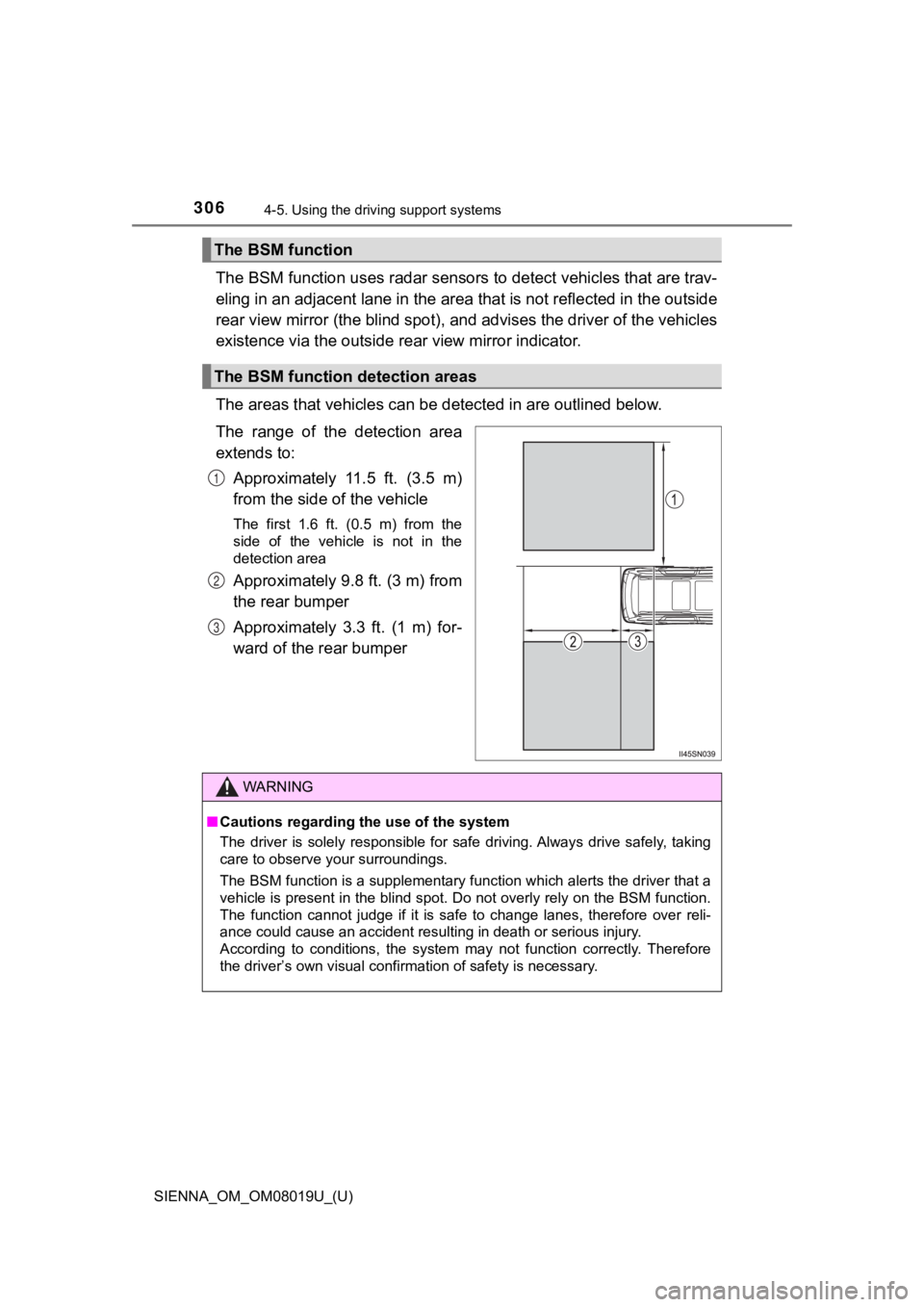
306
SIENNA_OM_OM08019U_(U)
4-5. Using the driving support systems
The BSM function uses radar sensors to detect vehicles that are trav-
eling in an adjacent lane in the area that is not reflected in the outside
rear view mirror (the blind spot), and advises the driver of th e vehicles
existence via the outside rear view mirror indicator.
The areas that vehicles can be detected in are outlined below.
The range of the detection area
extends to: Approximately 11.5 ft. (3.5 m)
from the side of the vehicle
The first 1.6 ft. (0.5 m) from the
side of the vehicle is not in the
detection area
Approximately 9.8 ft. (3 m) from
the rear bumper
Approximately 3.3 ft. (1 m) for-
ward of the rear bumper
The BSM function
The BSM function de tection areas
1
2
3
WARNING
■Cautions regarding the use of the system
The driver is solely responsible for safe driving. Always drive safely, taking
care to observe your surroundings.
The BSM function is a supplementary function which alerts the driver that a
vehicle is present in the blind spot. Do not overly rely on the BSM function.
The function cannot judge if it is safe to change lanes, theref ore over reli-
ance could cause an accident resulting in death or serious inju ry.
According to conditions, the system may not function correctly. Therefore
the driver’s own visual confirmation of safety is necessary.
Page 308 of 584
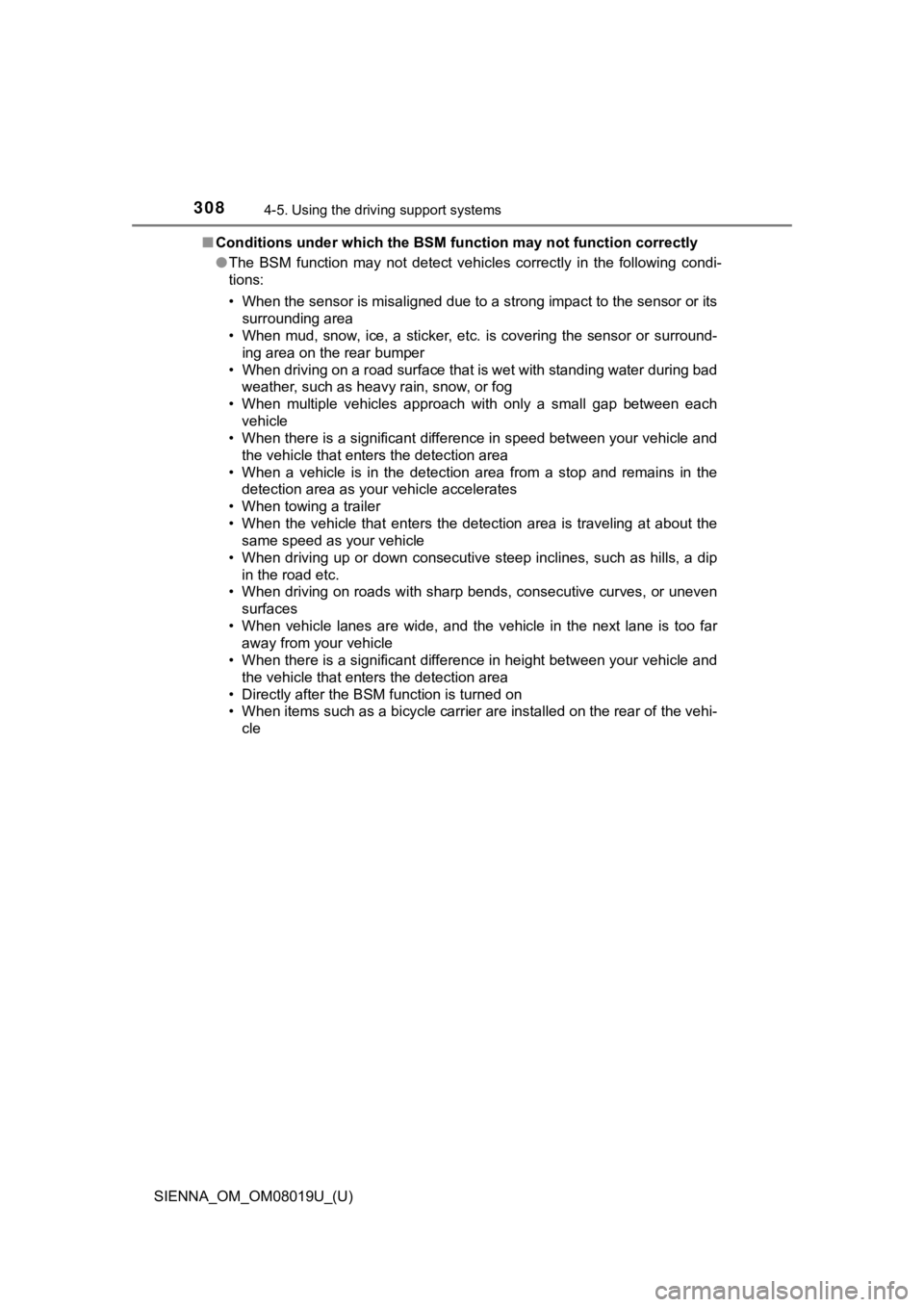
308
SIENNA_OM_OM08019U_(U)
4-5. Using the driving support systems
■Conditions under which the BSM function may not function correc tly
● The BSM function may not detect vehicles correctly in the following condi-
tions:
• When the sensor is misaligned due to a strong impact to the se nsor or its
surrounding area
• When mud, snow, ice, a sticker, etc. is covering the sensor or surround-
ing area on the rear bumper
• When driving on a road surface that is wet with standing water during bad
weather, such as heavy rain, snow, or fog
• When multiple vehicles approach with only a small gap between each vehicle
• When there is a significant difference in speed between your v ehicle and
the vehicle that enters the detection area
• When a vehicle is in the detection area from a stop and remains in the detection area as your vehicle accelerates
• When towing a trailer
• When the vehicle that enters the detection area is traveling a t about the
same speed as your vehicle
• When driving up or down consecutive steep inclines, such as hills, a dip in the road etc.
• When driving on roads with sharp bends, consecutive curves, or uneven
surfaces
• When vehicle lanes are wide, and the vehicle in the next lane is too far
away from your vehicle
• When there is a significant difference in height between your vehicle and
the vehicle that enters the detection area
• Directly after the BSM function is turned on
• When items such as a bicycle carrier are installed on the rear of the vehi-
cle
Page 309 of 584
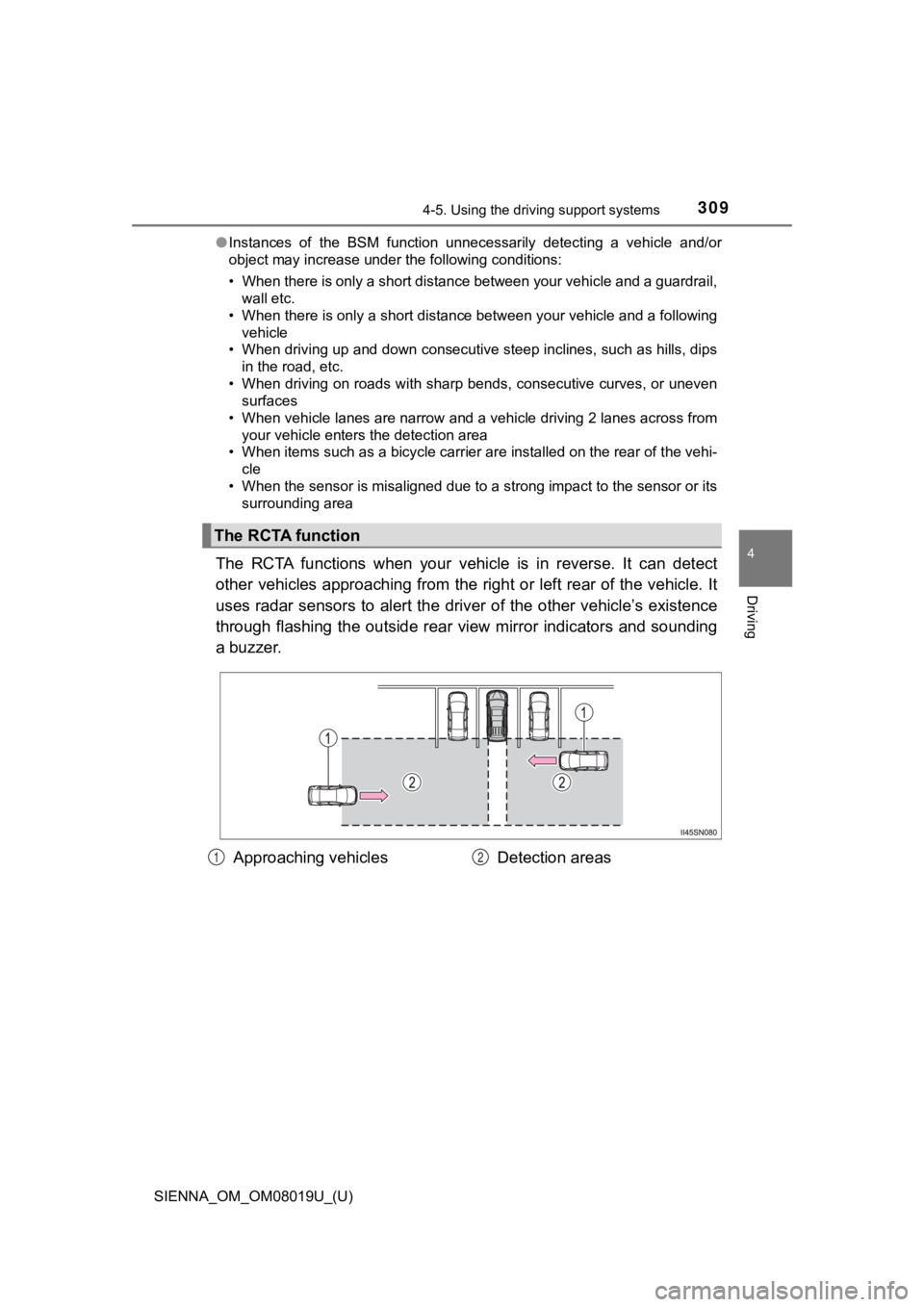
SIENNA_OM_OM08019U_(U)
3094-5. Using the driving support systems
4
Driving
●Instances of the BSM function unnecessarily detecting a vehicle and/or
object may increase under the following conditions:
• When there is only a short distance between your vehicle and a guardrail,
wall etc.
• When there is only a short distance between your vehicle and a following
vehicle
• When driving up and down consecutive steep inclines, such as hills, dips
in the road, etc.
• When driving on roads with sharp bends, consecutive curves, or uneven
surfaces
• When vehicle lanes are narrow and a vehicle driving 2 lanes ac ross from
your vehicle enters the detection area
• When items such as a bicycle carrier are installed on the rear of the vehi-
cle
• When the sensor is misaligned due to a strong impact to the se nsor or its
surrounding area
The RCTA functions when your vehicle is in reverse. It can dete ct
other vehicles approaching from the right or left rear of the v ehicle. It
uses radar sensors to alert the driver of the other vehicle’s existence
through flashing the outside rear view mirror indicators and so unding
a buzzer.
The RCTA function
Approaching vehicles Detection areas12
Page 311 of 584
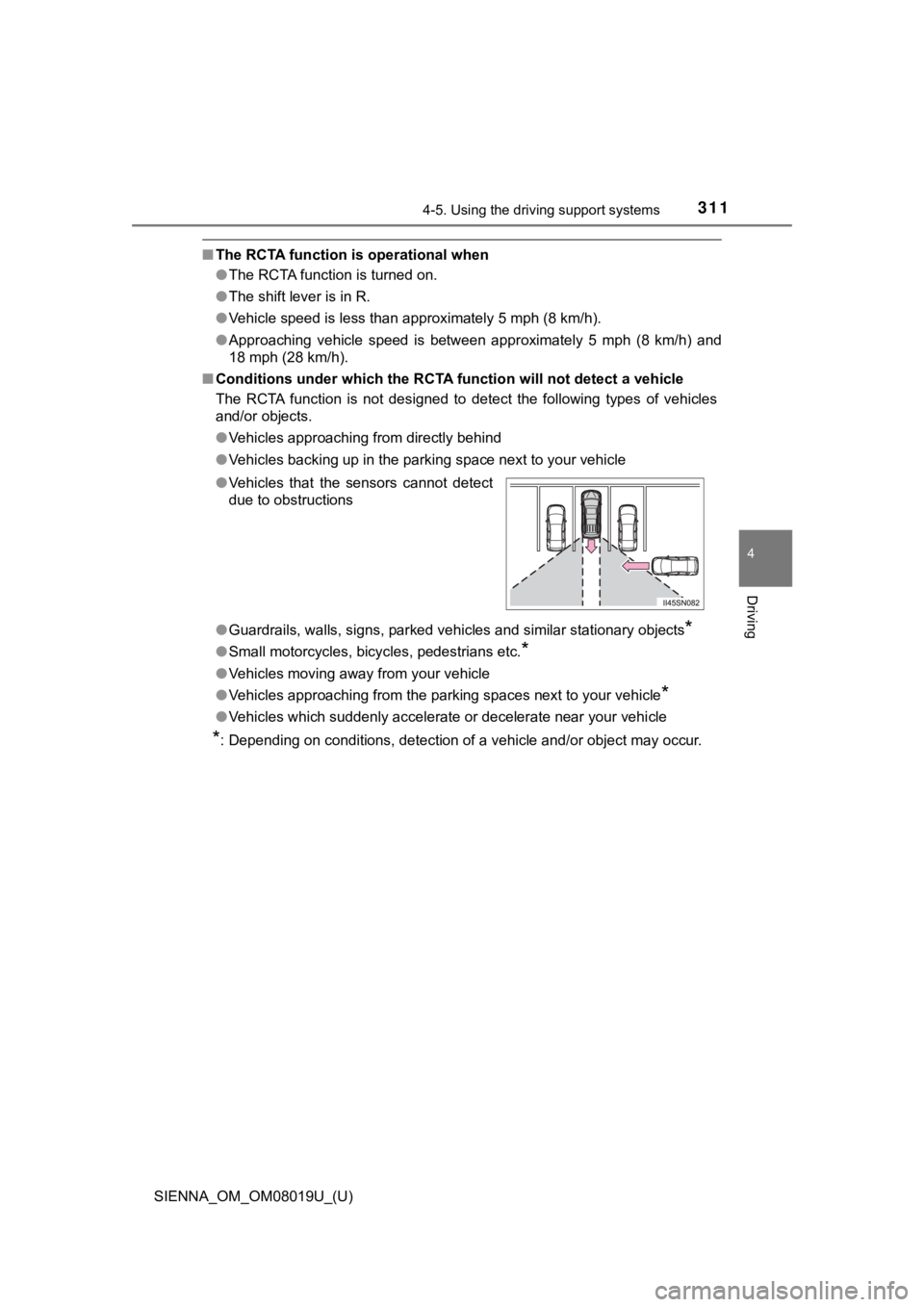
SIENNA_OM_OM08019U_(U)
3114-5. Using the driving support systems
4
Driving
■The RCTA function is operational when
●The RCTA function is turned on.
● The shift lever is in R.
● Vehicle speed is less than approximately 5 mph (8 km/h).
● Approaching vehicle speed is between approximately 5 mph (8 km/ h) and
18 mph (28 km/h).
■ Conditions under which the RCTA function will not detect a vehicle
The RCTA function is not designed to detect the following types of vehicles
and/or objects.
● Vehicles approaching from directly behind
● Vehicles backing up in the parking space next to your vehicle
● Guardrails, walls, signs, parked vehicles and similar stationar y objects
*
●Small motorcycles, bicycles, pedestrians etc.*
●Vehicles moving away from your vehicle
● Vehicles approaching from the parking spaces next to your vehic le
*
●Vehicles which suddenly accelerate or decelerate near your vehi cle
*: Depending on conditions, detection of a vehicle and/or object may occur.
●
Vehicles that the sensors cannot detect
due to obstructions
Page 312 of 584
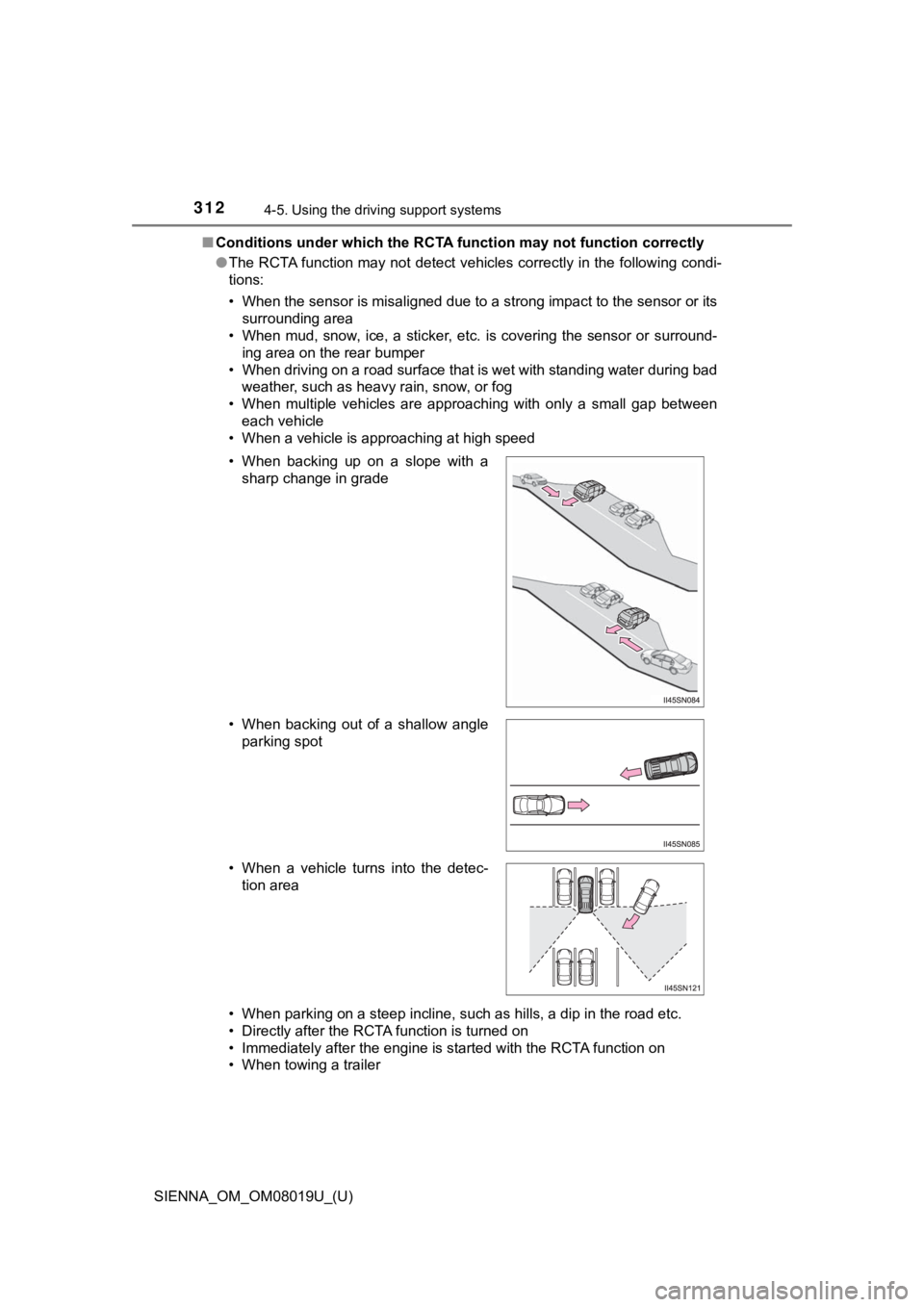
312
SIENNA_OM_OM08019U_(U)
4-5. Using the driving support systems
■Conditions under which the RCTA function may not function corre ctly
● The RCTA function may not detect vehicles correctly in the following condi-
tions:
• When the sensor is misaligned due to a strong impact to the se nsor or its
surrounding area
• When mud, snow, ice, a sticker, etc. is covering the sensor or surround-
ing area on the rear bumper
• When driving on a road surface that is wet with standing water during bad
weather, such as heavy rain, snow, or fog
• When multiple vehicles are approaching with only a small gap b etween
each vehicle
• When a vehicle is approaching at high speed
• When parking on a steep incline, such as hills, a dip in the r oad etc.
• Directly after the RCTA function is turned on
• Immediately after the engine is started with the RCTA function on
• When towing a trailer • When backing up on a slope with a
sharp change in grade
• When backing out of a shallow angle parking spot
• When a vehicle turns into the detec- tion area
Page 313 of 584
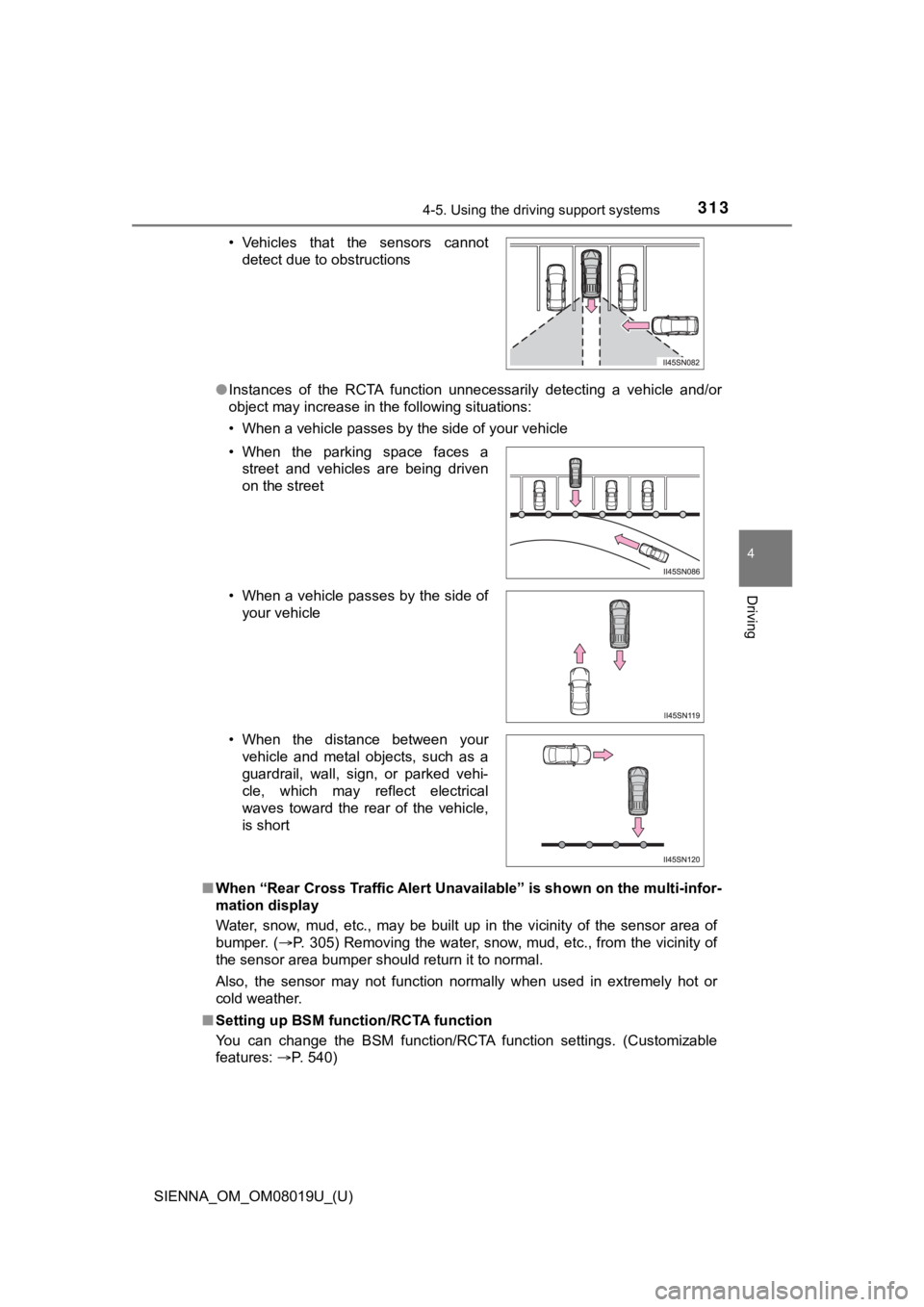
SIENNA_OM_OM08019U_(U)
3134-5. Using the driving support systems
4
Driving
●Instances of the RCTA function unnecessarily detecting a vehicl e and/or
object may increase in the following situations:
• When a vehicle passes by the side of your vehicle
■ When “Rear Cross Traffic Alert Unavailable” is shown on the mul ti-infor-
mation display
Water, snow, mud, etc., may be built up in the vicinity of the sensor area of
bumper. ( P. 305) Removing the water, snow, mud, etc., from the vicinity of
the sensor area bumper should return it to normal.
Also, the sensor may not function normally when used in extreme ly hot or
cold weather.
■ Setting up BSM function/RCTA function
You can change the BSM function/RCTA function settings. (Custom izable
features: P. 540) • Vehicles that the sensors cannot
detect due to obstructions
• When the parking space faces a street and vehicles are being driven
on the street
• When a vehicle passes by the side of your vehicle
• When the distance between your vehicle and metal objects, such as a
guardrail, wall, sign, or parked vehi-
cle, which may reflect electrical
waves toward the rear of the vehicle,
is short